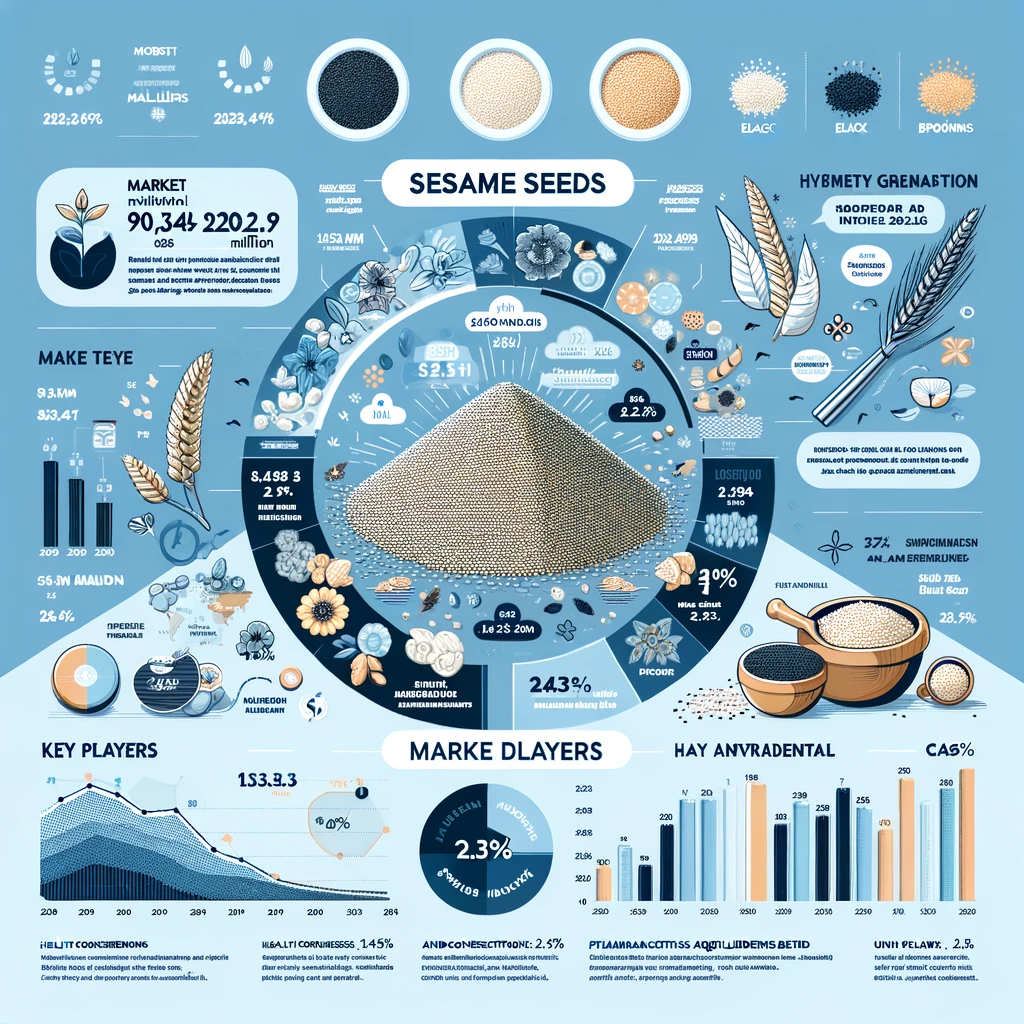Amidst the burgeoning global trend towards health and wellness, the sesame seeds market size is experiencing substantial growth, driven by an increasing consumer shift towards nutritious and wholesome foods. The market is projected to grow at a consistent compound annual growth rate (CAGR) of 2.3% from 2024 to 2032. This blog delves into the market dynamics, trends, and innovations shaping the global sesame seeds landscape, providing a comprehensive analysis for stakeholders.
Market Overview
Sesame seeds are prized for their nutritional benefits, including high protein, healthy fats, vitamins, and minerals. As consumers increasingly seek food options that offer health benefits beyond basic nutrition, sesame seeds have become a preferred ingredient in various culinary applications worldwide. The global market for sesame seeds is poised for steady growth, reflecting broader trends in health-conscious eating and sustainable agriculture.
Market Size and Forecast
The global sesame seeds market is anticipated to witness moderate growth over the forecast period, buoyed by rising health awareness and innovations in food processing and hybrid seed development. The integration of sesame seeds into diverse dietary regimes is expected to fuel their demand across various sectors, including bakery, confectionery, and health food products.
Market Dynamics
Key Drivers:
- Increasing Health Consciousness: With more consumers prioritizing health and wellness, there is a growing demand for foods that support a healthy lifestyle, positioning sesame seeds as a beneficial choice due to their nutrient-rich profile.
- Advancements in Agricultural Practices: Innovations in hybrid seed development are expected to increase sesame crop yields and quality, making sesame cultivation more profitable and sustainable.
- Rising Popularity in Global Cuisines: As global cuisine becomes more popular, sesame seeds are being used more frequently for their unique flavor and texture in dishes, further propelling their demand.
Market Challenges:
- Price Volatility: The price of sesame seeds can fluctuate significantly due to changes in global production levels affected by weather conditions and farming practices.
- Supply Chain Inefficiencies: Despite technological advancements, the sesame seed supply chain faces challenges related to storage, transportation, and quality control, impacting overall market growth.
Market Segmentation
The global sesame seeds market can be segmented based on type, application, and geography:
By Type:
- White Sesame Seeds
- Black Sesame Seeds
- Brown Sesame Seeds
By Application:
- Bakery and Confectionery
- Cosmetics
- Pharmaceuticals
- Dietary Supplements
- Others
By Region:
- North America: The U.S. and Canada are witnessing a rise in sesame seed consumption due to dietary diversity and the prevalence of health-centric diets.
- Europe: High demand in countries like Germany and the UK, driven by increasing use in bakery products and health foods.
- Asia-Pacific: Dominates the market with major producers and consumers like India and China. The traditional use of sesame seeds in Asian diets supports sustained growth.
- Latin America and Middle East & Africa: Growing interest in nutrient-rich seeds is slowly transforming dietary habits in these regions.
Recent Developments
- Innovation in Processing Technologies: New techniques in the processing and hulling of sesame seeds are improving their quality and applicability in different food sectors.
- Sustainable Farming Initiatives: Increased focus on sustainable and organic farming practices for sesame cultivation is enhancing market appeal among health-conscious consumers.
Key Players
- Olam International
- Dipasa Europe B.V.
- Unicorn Ingredients Limited
- Virdhara International
- Tradin Organic Agriculture B.V.
- Akay Agro Allied
- Others
These companies are leading the way in expanding global access to high-quality sesame seeds through strategic cultivation, processing innovations, and global distribution networks.
Market Trends
- Growth in Organic Products: There is a significant trend towards organic sesame seeds as consumers increasingly demand products free from pesticides and synthetic fertilizers.
- Expansion in Snack Foods: Sesame seeds are being incorporated into a variety of snack foods, capitalizing on the trend towards healthier snacking options.
Industry News
- Recent partnerships between key players and local farmers are aiming to stabilize supply chains and improve sesame seed quality, addressing both market demand and sustainability goals.
FAQs
1. What are the health benefits of sesame seeds?
- Sesame seeds are rich in protein, healthy fats, vitamins, and minerals, making them beneficial for heart health, digestion, and skin.
2. Which region holds the largest market share for sesame seeds?
- The Asia-Pacific region holds the largest share due to high consumption and production, particularly in countries like India and China.
3. What challenges do sesame seed producers face?
- Producers face challenges related to price volatility, supply chain inefficiencies, and the need for sustainable farming practices.
4. How are sesame seeds used in the food industry?
- They are used in bakery products, confections, health foods, and as garnishes in various dishes.
5. What trends are influencing the sesame seeds market?
- Key trends include the rise in organic sesame seed demand and their increasing use in global snack foods.
6. Who are the major players in the global sesame seeds market?
- Major players include Olam International, Dipasa Europe B.V., and Tradin Organic Agriculture B.V., among others.

